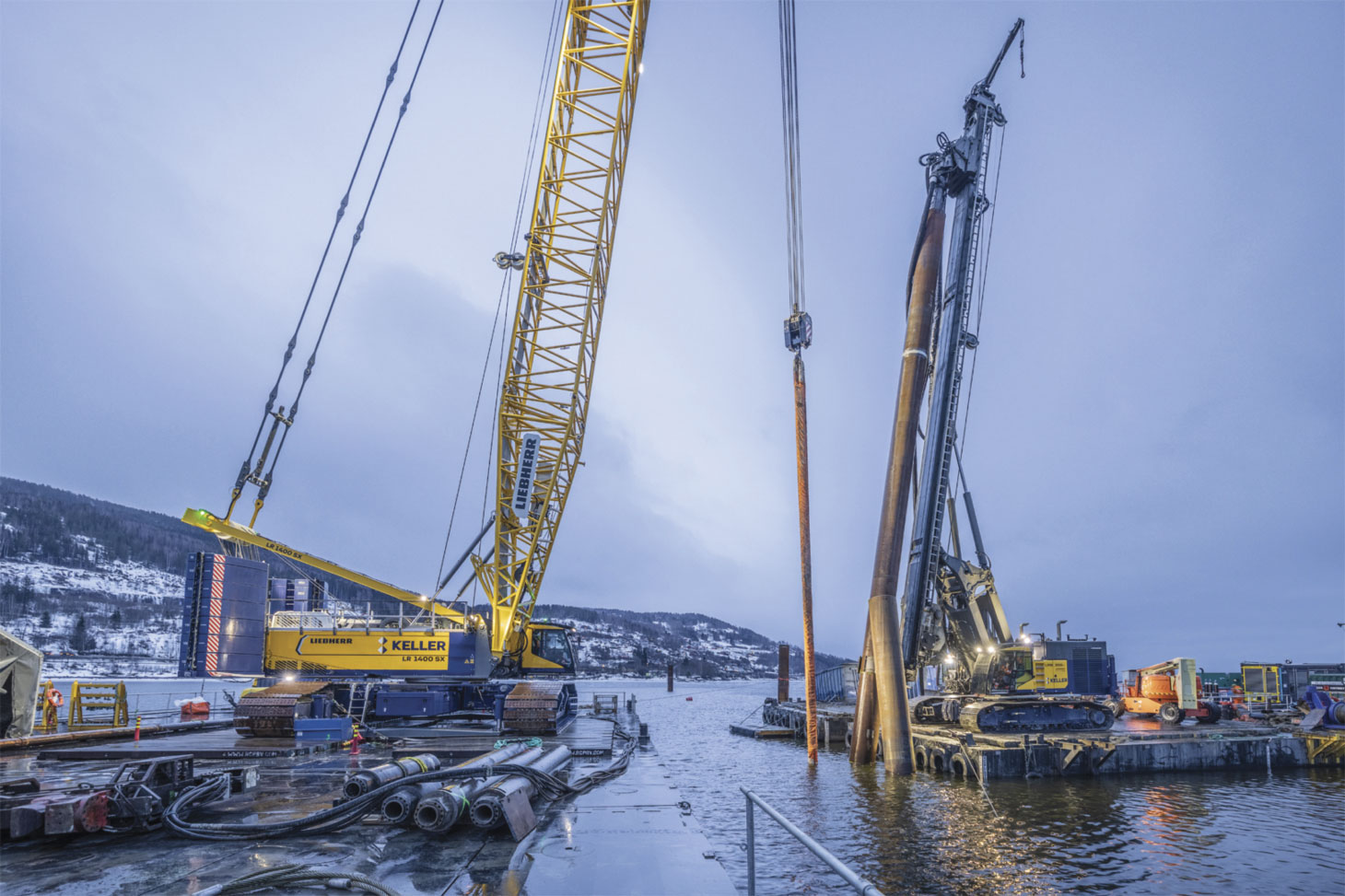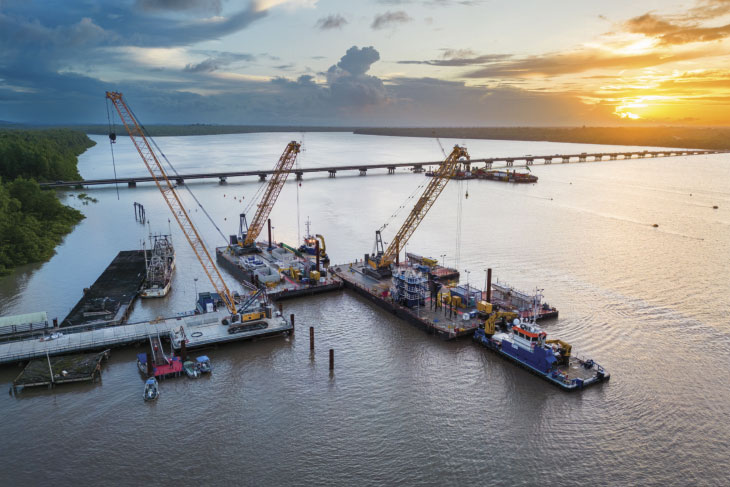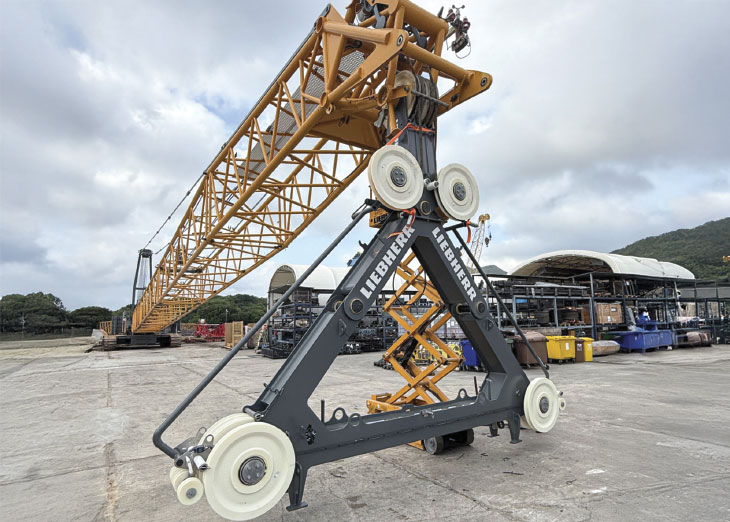
Using crawler cranes for lifting is one of the toughest and most safety-critical jobs in construction. Moving long, heavy loads on land is hard enough; doing it on floating platforms, such as barges, is even riskier. The smallest change in balance or angle can cause the load to swing dangerously, overload the crane or create a risk of tipping.
To address these challenges, Liebherr-Werk Nenzing GmbH developed new features for its LR series crawler cranes, which handle loads from 130 to 400 tonnes. The pile-tilting device and vertical line finder now let one operator do jobs that once required two cranes. The device replaces the standard rope pulley set on the boom and enables the operator to tilt or rotate heavy components from horizontal to vertical using the usual crane controls – without diagonal pull on the boom.
“It’s a helpful tool. The vertical line finder and the boom will automatically be adjusted to ensure that the weight, the load, is in the same line as the hook. So it’s a very safe and precise lift of the load,” said Dalibor Smigic, area manager for foundation equipment and heavy-duty crawler cranes.
From tandem to single-crane lifts
Liebherr’s new method eliminates the need for tandem lifts when tipping or turning long, heavy loads, streamlining the process, reducing costs and minimizing co-ordination risks. Previously, two cranes were required to work in confined spaces, and each operated below maximum capacity. Smigic explains that a two-crane lift is considered a “critical lift,” meaning more approvals are needed, more engineers involved, etc. He says it is Liebherr’s goal to avoid anything that falls under critical.
Liebherr’s pile-tilting device makes these lifts possible with a single LR crawler crane. The system replaces the standard pulley with two winches and hooks, which the operator can control together or separately for precise movement. It allows loads of up to 90 tonnes to be rotated smoothly from horizontal to vertical without causing sideways strain on the boom. Because the device is mounted in line with the original pulley, the crane’s balance and load limits remain unchanged, ensuring safety and maintaining full lifting capacity.

The innovation has immediate advantages for operators working on bridge projects, jetties, docks and wharfs. “It’s a two-hook operation,” Smigic explained. “We have two winches, and then you have a hook going left, the hook going right. Taking it from a horizontal to then swing it to the pile location where they can start to drive the pile.”
By handling the manoeuvre with one crane, crews avoid the complex and sometimes hazardous co-ordination between two operators. “Otherwise you would require two cranes, one for holding it at the bottom, one on the top and then going like the tilting device, which is more [costly]. It might be also a bit more dangerous, due to the proximity of the moving pieces to avoid side loading,” he said.
Safer, more efficient operations
Beyond precision, the pile-tilting device improves safety and efficiency on multiple fronts. The number of people in the danger zone is reduced, which is particularly important for urban and congested jobsites. Fewer cranes also mean reduced diesel consumption, lower emissions and decreased transport and setup costs.
“For some piles, you will need a second crane, which results automatically in a minimum of $30,000, for example, [a smaller one,] which would be required there to do the turnaround or the manoeuvre of the pile. And then of course, another barge – you have to put the crane somewhere – which results even in more costs and so on. And then again, another operator,” said Smigic.
Using just one crane can also speed up projects and removes the risk of mistakes from co-ordinating two operators. The vertical line finder helps with lifting other parts, like bridge or steel pieces. Smigic says that working in shallow water is less risky than working farther out at sea. The pile tilting device can be quickly removed, allowing the crane to return to standard lifting operations. This flexibility helps accelerate project timelines.
Vertical precision through intelligent sensors
Liebherr’s vertical line finder system takes accuracy to a new level. Using built-in sensors and Liebherr’s proprietary software, it automatically maintains the load’s vertical alignment, even if the barge or crane platform tilts slightly. The system constantly monitors the inclination of the boom and the position of the rope relative to the load.
“There is a sensor in the upper crane itself, which measures the inclination: one, two or three degrees. So, we know the position of the crane – is it inclined forward, backward, sideways… So, at every moment the crane calculates the inclination,” said Smigic.
“We are known to be innovative manufacturers and [are] respected in the market. The market is also expecting innovative solutions from us.”
Dalibor Smigic, Liebherr-Werk Nenzing GmbH
If the barge or the crane platform moves, the vertical line finder automatically adjusts the boom angle to keep the rope perfectly aligned above the load. “Now the system recognizes ‘Okay, we have to move [our boom slightly] forward to be exactly above the load.’ It means the system will give the signal to the software and [it] will adjust, it will move and it will give another signal to the boom winch, which will then be activated and adjust the angle to be exactly above the load ropes,” he said.
Smigic says the control system is powered by Liebherr’s own software, developed in-house and refined through extensive field testing. “We have a developing centre for various Liebherr products. And this is something which goes over the years until it’s proven and ready for the market,” he said.
According to Smigic, the development process for the vertical line finder and tilting device took at least three years. Testing began at Liebherr’s own proving grounds in Ehingen, Austria, before moving to select customer sites for real-world validation. “The resonance was more than positive,” he said. “Finally getting a system correcting the values itself and also to ensure a safe and precise hookup of the load. It’s a milestone.”
Built for the realities of marine construction
Working from floating platforms adds layers of complexity that land-based lifting operations don’t face. Waves, wind and variable water levels can shift the balance of a barge within seconds. Liebherr’s system mitigates those risks by automatically adjusting load charts based on real-time conditions.
“One absolutely necessary part is that the system recognized the inclination of the barge,” said Smigic. “If it’s, I mean, up to 10 per cent, you can’t work. You have to ensure that the crane is really fixed and it cannot move or fly down from the barge. And if you have big waves, you’ll stop the operation depending on the weather or do the same also for the wind.”

The crane’s integrated anemometer and inclination sensors monitor these environmental factors continuously. “The more the barge is inclined, the more the load chart will be reduced because of safety reasons. And simply you can’t do lifting with 100 per cent capacity,” he said.
That same monitoring system also applies on land, where wind is the dominant hazard. “The floating unit operation, that barge operation, is a bit specific because it integrates automatically recognition of the inclination itself and therefore the reduction, which has to be on the load chart,” Smigic said. “And on land, for example, that’s way smoother and better. There is more the risk of strong wind. Wind is so-called a reduction factor, the biggest on land, especially in windy areas.”
Ready for the Canadian market
While the system has yet to be deployed in Canada, Smigic says customer interest is growing. “There are [Canadian] customers interested, some existing crane customers, and there are projects around. We already priced [for them]. They are working on ports infrastructure and bridge projects.”
The technology is particularly relevant to Canada’s infrastructure and marine development markets, where bridge replacements, port upgrades and shoreline reinforcement projects are ongoing. The system’s ability to perform high-precision lifts on barges and in confined areas could make it a valuable addition to fleets operating on the St. Lawrence River, the Great Lakes and the West Coast. For Liebherr, innovation is never static. Smigic says this is not a final product or solution. He envisions future versions incorporating artificial intelligence to further enhance precision and automation.
“Maybe one day we will be able to do calculations beyond three degrees, let’s say up to five degrees, or maybe more precise calculating of the control of the verticality of the ropes,” he said. “Maybe in combination with AI, if we go there and I can talk to the computer of the crane and say, ‘Listen, that has to be done.’ … it’s kind of pre-recognition, pre-settings where we’re talking to the AI computer. Maybe in the future, I would say it will definitely go this direction.”
That forward-looking mindset reflects Liebherr’s long-standing reputation for pushing boundaries in construction machinery. Smigic, who began as a mechanic in 1994 and joined Liebherr in 2005, has seen that culture of innovation first-hand. “We are known to be innovative manufacturers,” he said, “and respected in the market. The market is also expecting such innovative solutions from us.”
For Liebherr, that innovation comes from collaboration – between engineers, customers and service teams across regions. “It’s a whole so-called strain,” said Smigic. “Our people at the front, like our team at Liebherr Canada, our divisional director, the service team, product management, sales and engineering. Everyone is connected.”
Precision, safety and trust
From the first prototypes to customer-ready solutions, Liebherr’s goal is to make lifting safer and more efficient, no matter the environment. For Smigic, seeing these innovations reach the field is the most rewarding part. “Finally getting a system correcting the values itself and also to ensure a safe and precise hookup of the load – it’s a kind of a milestone,” he said.
As the technology spreads to new markets, including Canada, it will carry forward Liebherr’s philosophy of safety through innovation – proving once again that in the world of heavy lifting, precision is power.